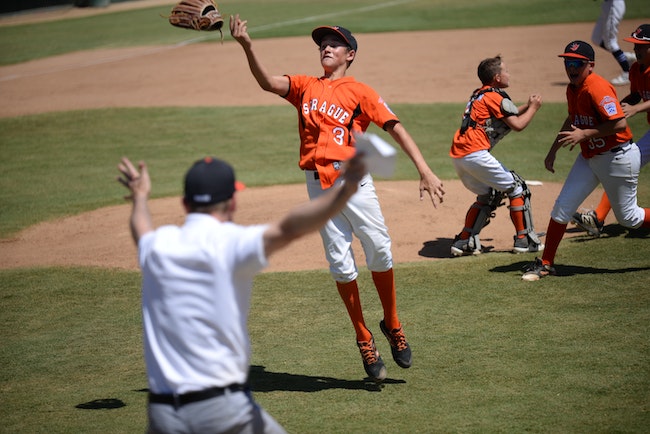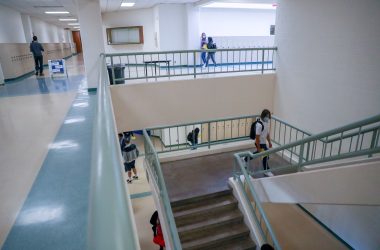 Players from the Sprague Little League team celebrate Saturday as they win the Northwest regional Little League tournament. (Photo courtesy Traci McHenry)
Players from the Sprague Little League team celebrate Saturday as they win the Northwest regional Little League tournament. (Photo courtesy Traci McHenry)
A picture has started to emerge of what school might look like when classes return in the fall, but there’s still a large unknown when it comes to the playing fields.
Athletes could start conditioning next month, but its unclear what higher-contact sports like football will look like when school returns. School officials said discussions are still early in the process as they digest guidance the Oregon Education Department released Wednesday.
On Friday, June 5 Oregon School Activities Association released guidance for players practicing during the summer which requires students maintain a six-foot distance from others, limits the number of people on an outdoor field to 100, limits indoor gatherings to 50 and prohibits high fives, fist bumps, hugs and group celebrations.
The guidance also addresses individual sports with more specific guidance.
Sports considered to have a lower infection risk include cross country, track and field, swimming, tennis, golf and speech.
Tennis players have to limit sharing tennis balls and swimmers can only have one swimmer per lane.
Sports considered to have a moderate risk include volleyball, soccer, baseball, softball and basketball.
Those sports require players to limit equipment sharing to pods, disinfecting frequently and stay 6 feet apart.
Higher infection risk sports such as football, wrestling, cheerleading, dance and music aren’t allowing contact.
Football players aren’t allowed to tackle other students and dummies or other equipment have to be sanitized after each “pod,” or group of ten or less.
Wrestlers may “skill and drill” without contacting a teammate, cheerleaders can’t stunt and OSAA recommends restricting music rehearsals.
Larry Ramirez, director of high school education with the Salem-Keizer School District, said the district’s athletic directors met Thursday to go over Oregon School Activities Association guidance and start developing plans for summer conditioning with pods.
Ramirez emphasized it’s still early in the process and too soon to say what fall sports will look like.
“It’s an ever-evolving thing,” he said, adding that there will be updates throughout the summer.
Right now, they’re discussing having groups of kids do conditioning during the summer while staying within the parameters of the guidance by writing down names, sanitizing balls between pods and taking temperatures.
“We’re making plans so hopefully in July that we can start opening up to a point where we can have some kids on campus,” Ramirez said.
Brian Armstrong, athletic director at South Salem High School, said there are a lot of variables he has no control over and right now the district is focusing on what athletes are able to do in the summer.
The area’s athletic directors are planning to present facility protocol plans to district staff in two weeks in the hopes of opening for conditioning on July 1.
Armstrong said they’re talking about adding trainings for coaches on sanitizing.
Bill Wittman, athletic director at West Salem High School, said everyone, including him, have a lot of questions right now.
Because of group size limitations, Wittman said they’re likely going to run shifts to cycle kids through conditioning.
Wittman said his biggest concern is making sure they do everything properly to avoid an outbreak that could jeopardize the fall sports season.
“We’re really just talking about weight training and conditioning right now,” he said.
Peter Weber, executive director of the OSAA, said ODE’s guidance Wednesday helps begin a framework for what sports might look like in the fall.
“That’ll start to set the tone a little bit about what sorts of parameters are in place,” he said.
Weber said OSAA doesn’t have answers to some questions yet, like whether or not wrestling can continue with “no contact.”
He said ODE’s guidance allows schools to determine what changes will look like locally. However, he said athletics will more than likely take a statewide approach.
Weber said his organization wants to put guidance out for fall sports as soon as possible but hasn’t determined a date.
“Participating in sports and activities is a critical piece to the growth of the student. Certainly, we’re advocating for the ability to provide those opportunities in a safe manner,” Weber said.
Weber said his organization formed groups to brainstorm scenarios for different sports that are slated to start practicing on Aug. 17.
The groups — one for cheerleading, soccer, football, cross country, dance and volleyball – are meeting twice a month to come up with a plan on how to return to athletics in the coming months.
In the football contingency meeting on May 28, participants voiced concerns that contact is always part of the game even with a smaller seven on seven match, according to meeting minutes.
In the meeting notes under “worst case competition scenario” it said to delay the season as long as possible or consider moving it to the spring.
“Give kids the opportunity to play. 2 games are better than nothing,” one bullet read.
At the soccer contingency meeting on May 28, members said changes will probably be good for the game of soccer by creating proper lines and spacing.
“In soccer, the individual drill foundation is so important, being able to dribble, striking the ball, free kicks, going to the goal without a goalie, combination of ball receiving are all components that coaches can apply in Phase 2,” meeting minutes read.
The volleyball meeting minutes on June 1 said “will the girls be able to stop themselves from running for a ball in their teammate’s space to save it? That is what they are trained to do.”
On May 29, cheerleading officials said no physical contact will limit athletes from being able to do much of anything moving forward.
“The physical contact needed for safe spotting is very important and how to keep students safe during the learning that takes place in practices,” meeting minutes read.
RELATED COVERAGE: Salem-Keizer schools grapple with transportation, clubs, childcare as they plan for reopening
SUPPORT SALEM REPORTER’S JOURNALISM – A monthly subscription starts at $5. Go HERE. Or contribute to keep our reporters and photographers on duty. Go HERE. Checks can be sent: Salem Reporter, 2925 River Rd S #280 Salem OR 97302. Your support matters.
Have a tip or story idea? Contact reporter Saphara Harrell at 503-549-6250, [email protected] or @daisysaphara.









